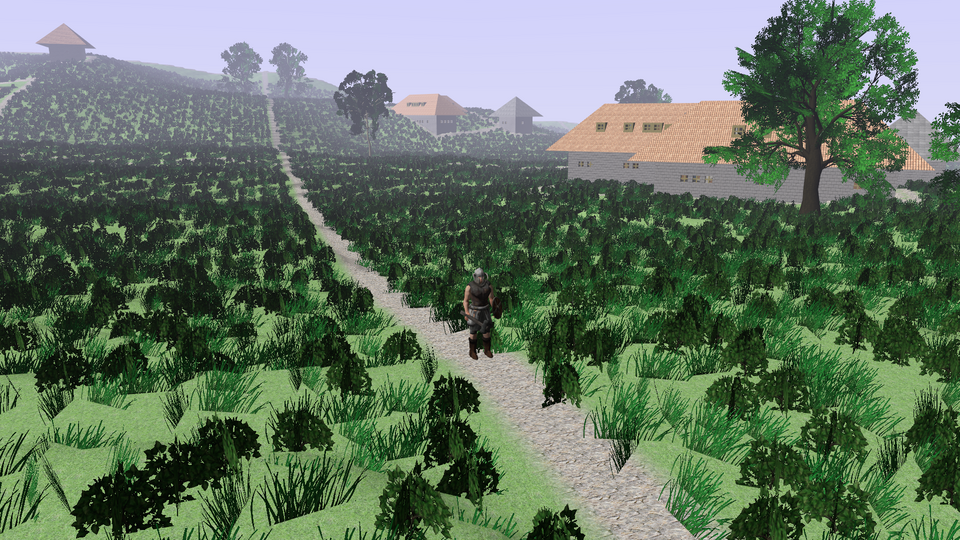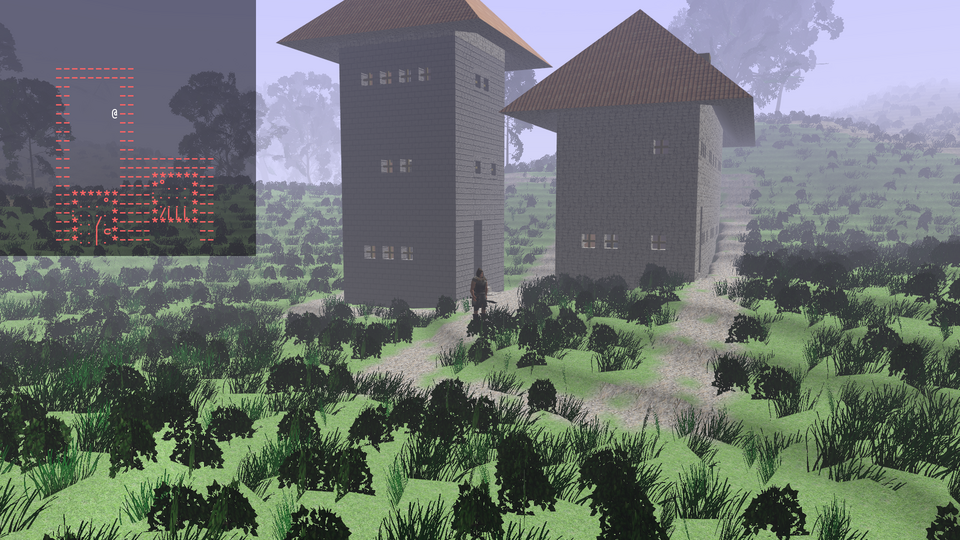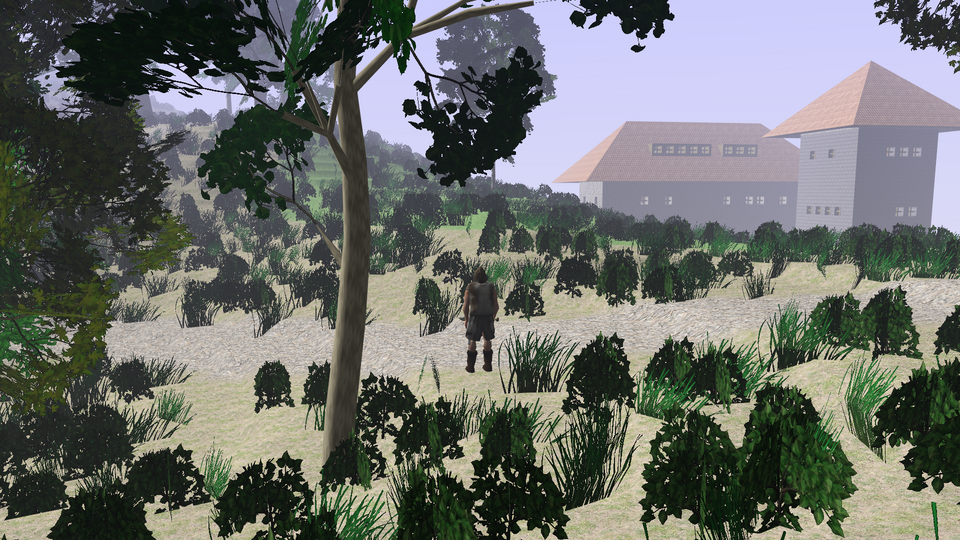
Discover a huge persistent world with randomly generated terrain, settlements and buildings!
Explore a varying landscape, enter structures and meet its peaceful looking inhabitants!
At least, this is what it looks like on the surface..
Fight your way through dangerous forests and canyons off the pathes on the map!
Explore mysterious places and find access to the underworld
where ordinary looking places above can be very special beneath!
Found and build your own home, expand it and define your own riddle to underworld access!
Live your second life in the underworld but be careful.
The longer you stay the more you will change in some way..


Land of Zonibo is a fantasy RPG which currently runs on windows desktop, android and most current browsers.
You play on the same large persistent world on all of these platforms.
Play on your own or join a party and accomplish quests together (cross device play supported!).
There is also a standalone version planned where you can create your own worlds with advanced server tools.
At the moment Land of Zonibo is work in progress but you can look at the current state of development here: Demo

Land of Zonibo uses an interesting approach to establish a huge, living simulation which is based on ASCII maps, random generation and voxels.
These techniques are used to generate and simulate a true 3D world on top of it (for more details see "Technical background").
The result is a large and persistent world, terrain reaching from kilometres above the ground and also below it, vegetation from wood to steppe, a labyrinth of pathes connecting vivid smaller and larger settlements.
Special is also the multi-platform support. The game looks almost the same wether played on mobile, browser or desktop.
The point-and-click style of movement control works equally across platforms and is ideal to play together across devices.
The story is driven through gameplay elements evolving by the ambivalence between the surface land and the underworld.
Different life forms which exist closely to each other but also decay over time play a big role throughout the story and gameplay elements.
E.g. every part in Land of Zonibo can age and will change its appearance to reflect this.


- Huge persistent online world with sandbox elements (offline also possible on PC)
- Uses a unqiue approach to generate 3D from ASCII
- Real cross device play (Web, Android, Windows, iOS in developement)
- Diablo-style (one hand free) player movement control but with a more free camera
- The game is build as a multiplayer game from the ground up. A public server will be setup until early access.
- The game can also be played offline. This comes only for windows. If you get the server software you are free to start your own server and play from all devices, naturally.
- Because of the way the character is controlled (point and click), there will be no really disadvantage in this aspect wether playing on a phone or tablet, on the PC or on the browser.
- Quick and easy build your house with a floor layout editor even on the smartphone (this is currently a tool application but will be integrated ingame) Build many floors above but also under the ground Leave your traces in the world by placing items, inscriptions or even a ghost as relic after player death
- The world is extensible in all directions, so even if the game will deliver a complete story with a major goal it is planned to enlarge the world constantly, create new locations and quests. If you are an early adopter you can witness this process closely.
- For advanced users: Create your own world and your own server: The server is just a command line app and is accessed by the clients through a web service. The server can be administered by a comfortabel UI.
- Almost identical graphics on PC/web/mobile (only slightly different shaders)
- Voxel based terrain: Every house's cellar is digged into the ground, caves and huge hallways play an important role for the "underworld"
- Every part of structures is aging which is visually shown.
- Safe areas: Pathes and areas where you won’t be attacked by monsters and NPC enemies
- Some similarities to roguelikes in the underlying game mechanics (procedurally generated terrain, buildings, dungeons, monsters and items) but no permadeath
- NPCs will have day/night cycle and follow a schedule
- NPCs memory: they remember interesting events happened near them like players they have seen/talked to, fights, elaborated weapons/items players have carried nearby etc.
- Time based fighting where you benefit if you are guessing the attack patterns of different monsters/NPC (attack/block/special), you also have a chance to retreat from a fight at low health
- Simplified crafting, just throw your stuff on a workbench
- Focus more on weapon/equipment improvement than on often changing them.
- Above features are mostly work in progress, features can be added or abandoned (for good reasons) in the future


The world generation is done in several steps.
At first multiple layers of ASCII maps are generated (known from roguelike games).
The underlying simulation runs on on these maps. This approach allows to handle a huge world with massive amounts of NPCs and items.
This is used on a large scale by generating or editing height and biome maps and on a lower scale down to placing NPCs and items.
For example a building or arbitrary structure can be generated or altered just by editing an ASCII floor plan and uploading it to the server which then creates 3D assets. This can happen while the server is running and is used for a variety of sandbox elements.
There are special zones for buildings and other structures which correspond to lower scale detail maps. These maps are also randomely created at first and can be altered by players or the server tool.
In order that the client user sees everything in 3D, the server side ASCII maps are first transformed to voxels for terrain and special sparse voxels for structures like buildings. From there on 3D meshes are generated. This process happens also when the maps are changing. The server also ensures proper path finding by creating a navigation map.
The game uses a custom engine because it is very difficult to squeeze the needed functionality out of existing engines like Unity or Unreal and at the same time ensuring that it runs well on mobile and web also.
Even when the game runs offline a „State Service“ is started which maintains the current state oft he game. This state is also frequently saved and can be used to record demos even in multiplayer. On a public server a web service sits in front oft he state service and processes all requests from connected clients.
